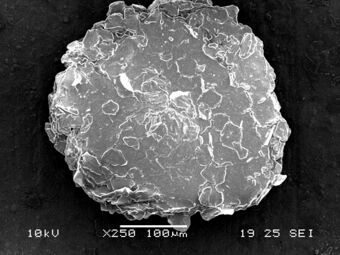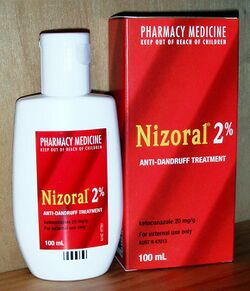Medicine:Dandruff
| Dandruff | |
|---|---|
| Other names | Pityriasis capitis, pityriasis sicca[1] |
 | |
| A microscopic image of human dandruff | |
| Specialty | Dermatology |
| Symptoms | Itchy and flaking skin of the scalp[2][1] |
| Usual onset | Puberty[1] |
| Causes | Genetic and environmental factors[1] |
| Diagnostic method | Based on symptoms[3] |
| Differential diagnosis | Psoriasis, dermatitis, tinea capitis[2][1] |
| Medication | Antifungal cream (ketoconazole), salicylic acid[2][1] |
| Frequency | ~50% of adults[1] |
Dandruff is a skin condition that mainly affects the scalp.[1] Symptoms include flaking and sometimes mild itchiness.[1][2] It can result in social or self-esteem problems.[4] A more severe form of the condition, which includes inflammation of the skin, is known as seborrhoeic dermatitis.[1]
The cause is unclear, but believed to involve a number of genetic and environmental factors;[1] the condition may worsen in the winter.[5] It is not due to poor hygiene,[6] [7] and the underlying mechanism involves the excessive growth of skin cells.[5] Diagnosis is based on symptoms.[3]
There is no known cure for dandruff.[8] Antifungal cream, such as ketoconazole, or the keratolytic agent salicylic acid may be used to try to improve the condition.[1][2] Dandruff affects about half of adults, with males more often affected than females.[1] In addition, people in all areas of the world are affected.[1] Onset is usually at puberty, and it becomes less common after the age of 50.[1]
Signs and symptoms
The main symptoms of dandruff are an itchy scalp and flakiness.[9] Red and greasy patches of skin and a tingly feeling on the skin are also symptoms.[10]
Causes

The cause is unclear but believed to involve a number of genetic and environmental factors.[7]
As the skin layers continually replace themselves, cells are pushed outward where they die and flake off. For most individuals, these flakes of skin are too small to be visible. However, certain conditions cause cell turnover to be unusually rapid, especially in the scalp. It is hypothesized that for people with dandruff, skin cells may mature and be shed in two to seven days, as opposed to around a month in people without dandruff. The result is that dead skin cells are shed in large, oily clumps, which appear as white or grayish flakes on the scalp, skin and clothes.
According to one study, dandruff has been shown to be possibly the result of three factors:[11]
- Skin oil, commonly referred to as sebum or sebaceous secretions[12]
- The metabolic by-products of skin micro-organisms (most specifically Malassezia yeasts)[13][14][15][16][17]
- Individual susceptibility and allergy sensitivity.
Microorganisms
Older literature cites the fungus Malassezia furfur (previously known as Pityrosporum ovale) as the cause of dandruff. While this species does occur naturally on the skin surface of people both with and without dandruff, in 2007, it was discovered that the responsible agent is a scalp specific fungus, Malassezia globosa,[18] that metabolizes triglycerides present in sebum by the expression of lipase, resulting in a lipid byproduct: oleic acid. During dandruff, the levels of Malassezia increase by 1.5 to 2 times its normal level.[5] Oleic acid penetrates the top layer of the epidermis, the stratum corneum, and evokes an inflammatory response in susceptible people which disturbs homeostasis and results in erratic cleavage of stratum corneum cells.[15]
Bacteria are also suspected to be a cause. Staphylococcus capitis was found to be 100 times more abundant on scalps affected by dandruff.[19]
Seborrhoeic dermatitis
In seborrhoeic dermatitis, redness and itching frequently occur around the folds of the nose and eyebrow areas, not just the scalp. Dry, thick, well-defined lesions consisting of large, silvery scales may be traced to the less common condition of scalp psoriasis. Inflammation can be characterized by redness, heat, pain or swelling, and can cause sensitivity.
Inflammation and extension of scaling outside the scalp exclude the diagnosis of dandruff from seborrhoeic dermatitis.[12] However, many reports suggest a clear link between the two clinical entities - the mildest form of the clinical presentation of seborrhoeic dermatitis as dandruff, where the inflammation is minimal and remains subclinical.[20][21]
Seasonal changes, stress, and immunosuppression seem to affect seborrheic dermatitis.[5]
Mechanism
Dandruff scale is a cluster of corneocytes, which have retained a large degree of cohesion with one another and detach as such from the surface of the stratum corneum. A corneocyte is a protein complex that is made of tiny threads of keratin in an organised matrix.[22] The size and abundance of scales are heterogeneous from one site to another and over time. Parakeratotic cells often make up part of dandruff. Their numbers are related to the severity of the clinical manifestations, which may also be influenced by seborrhea.[5]
Treatment

Shampoos use a combination of special ingredients to control dandruff.
Antifungals
Antifungal treatments including piroctone olamine, ketoconazole (Nizoral), zinc pyrithione, and selenium disulfide (Selsun Blue) have been found to be effective.[9] Ketoconazole appears to have a longer duration of effect.[9] Ketoconazole is a broad-spectrum antimycotic agent that is active against Candida and M. furfur. Of all the antifungals of the imidazole class, ketoconazole has become the leading contender among treatment options because of its effectiveness in treating seborrheic dermatitis as well.[5]
Ciclopirox (topical route) may also be used as an anti-dandruff agent.[23][24][25] However, it is mostly sold as cream and its main use is for treating athlete's foot, jock itch, and ringworm.[26]
Other than zinc pyrithione, the most common anti-dandruff actives (outside the US) and part of many cosmetic shampoos, are piroctone olamine and climbazole. Very recent anti-dandruff shampoos use a new ester technology, propanediol caprylate.
Exfoliating agents
Coal tar causes the skin to shed dead cells from the top layer and slows skin cell growth.[27]
Salicylic acid is an approved anti-dandruff active as per the US FDA OTC drug monograph and also used in many cosmetic anti-dandruff shampoos globally.
Etymology
According to the Oxford English Dictionary, the word dandruff is first attested in 1545,[28] but is still of unknown etymology.[28]
References
- ↑ 1.00 1.01 1.02 1.03 1.04 1.05 1.06 1.07 1.08 1.09 1.10 1.11 1.12 1.13 1.14 "Seborrheic Dermatitis". StatPearls [Internet].. Treasure Island (FL): StatPearls Publishing. August 2021.
- ↑ 2.0 2.1 2.2 2.3 2.4 "Dandruff" (in en). 18 October 2017. https://www.nhs.uk/conditions/dandruff/.
- ↑ 3.0 3.1 "Patient education: Seborrheic dermatitis (including dandruff and cradle cap) (Beyond the Basics)". https://www.uptodate.com/contents/seborrheic-dermatitis-including-dandruff-and-cradle-cap-beyond-the-basics.
- ↑ "A practical guide to scalp disorders". The Journal of Investigative Dermatology. Symposium Proceedings 12 (2): 10–14. December 2007. doi:10.1038/sj.jidsymp.5650048. PMID 18004290.
- ↑ 5.0 5.1 5.2 5.3 5.4 5.5 "Dandruff: the most commercially exploited skin disease". Indian Journal of Dermatology 55 (2): 130–134. 2010. doi:10.4103/0019-5154.62734. PMID 20606879.
- ↑ Dandruff. National Health Service
- ↑ 7.0 7.1 "Dandruff: How to treat". https://www.aad.org/public/diseases/hair-and-scalp-problems/dandruff-how-to-treat.
- ↑ The Encyclopedia of Skin and Skin Disorders (Third ed.). Facts On File, Inc.. 2007. p. 100. ISBN 978-0-8160-6403-8. https://books.google.com/books?id=GKVPHoIs8uIC&q=dandruff%20no%20cure&pg=PA100.
- ↑ 9.0 9.1 9.2 "Stratum corneum dysfunction in dandruff". International Journal of Cosmetic Science 34 (4): 298–306. August 2012. doi:10.1111/j.1468-2494.2012.00723.x. PMID 22515370.
- ↑ "What Is Dandruff? Learn All About Dandruff". Medical News Today. http://www.medicalnewstoday.com/articles/152844.php#symptoms_of_dandruff.
- ↑ "Three etiologic facets of dandruff and seborrheic dermatitis: Malassezia fungi, sebaceous lipids, and individual sensitivity". The Journal of Investigative Dermatology. Symposium Proceedings 10 (3): 295–297. December 2005. doi:10.1111/j.1087-0024.2005.10119.x. PMID 16382685.
- ↑ 12.0 12.1 "The role of sebaceous gland activity and scalp microfloral metabolism in the etiology of seborrheic dermatitis and dandruff". The Journal of Investigative Dermatology. Symposium Proceedings 10 (3): 194–197. December 2005. doi:10.1111/j.1087-0024.2005.10104.x. PMID 16382662.
- ↑ "Immunology of diseases associated with Malassezia species". Clinical Microbiology Reviews 15 (1): 21–57. January 2002. doi:10.1128/CMR.15.1.21-57.2002. PMID 11781265.
- ↑ "Malassezia Baillon, emerging clinical yeasts". FEMS Yeast Research 5 (12): 1101–1113. December 2005. doi:10.1016/j.femsyr.2005.05.006. PMID 16084129.
- ↑ 15.0 15.1 "Malassezia and seborrheic dermatitis: etiology and treatment". Journal of Cosmetic Science 57 (2): 181–182. 2006. PMID 16758556.
- ↑ "Fast, noninvasive method for molecular detection and differentiation of Malassezia yeast species on human skin and application of the method to dandruff microbiology". Journal of Clinical Microbiology 40 (9): 3350–3357. September 2002. doi:10.1128/JCM.40.9.3350-3357.2002. PMID 12202578.
- ↑ "Skin diseases associated with Malassezia species". Journal of the American Academy of Dermatology 51 (5): 785–798. November 2004. doi:10.1016/j.jaad.2003.12.034. PMID 15523360.
- ↑ "Genetic code of dandruff cracked". BBC News. 6 November 2007. http://news.bbc.co.uk/2/hi/health/7080434.stm.
- ↑ One step closer to finding the root cause of dandruff - Unilever
- ↑ "Revisiting dandruff". International Journal of Cosmetic Science 28 (5): 311–318. October 2006. doi:10.1111/j.1467-2494.2006.00326.x. PMID 18489295.
- ↑ Pierard-Franchimont C, Hermanns JF, Degreef H, Pierard GE. From axioms to new insights into dandruff. Dermatology 2000;200:93-8.
- ↑ "The Structure and Function of the Stratum Corneum". Dermatology.about.com. http://dermatology.about.com/od/anatomy/ss/sc_anatomy_2.htm.
- ↑ "Ciclopirox 1% shampoo for the treatment of seborrheic dermatitis". International Journal of Dermatology 45 (1): 66–69. January 2006. doi:10.1111/j.1365-4632.2004.02331.x. PMID 16426382.
- ↑ "Ciclopirox shampoo for treating seborrheic dermatitis". Skin Therapy Letter 9 (6): 4–5. June 2004. PMID 15334279. https://pubmed.ncbi.nlm.nih.gov/15334279/.
- ↑ "Ciclopirox (Topical Route) Description and Brand Names - Mayo Clinic". https://www.mayoclinic.org/drugs-supplements/ciclopirox-topical-route/description/drg-20062888.
- ↑ "Ciclopirox Topical: Uses, Side Effects, Interactions, Pictures, Warnings & Dosing - WebMD" (in en). https://www.webmd.com/drugs/2/drug-18039-433/ciclopirox-topical/ciclopirox-topical/details.
- ↑ "Anti-Dandruff (coal tar)". 16 August 2017. http://www.webmd.com/drugs/drug-151769-Anti-Dandruff+coal+tar+Top.aspx?drugid=151769&drugname=Anti-Dandruff+(coal+tar)+Top.
- ↑ 28.0 28.1 "dandruff | dandriff, n." OED Online. Oxford University Press, March 2015. Web. Retrieved 27 April 2015.
External links
| Classification |
|---|
 |

